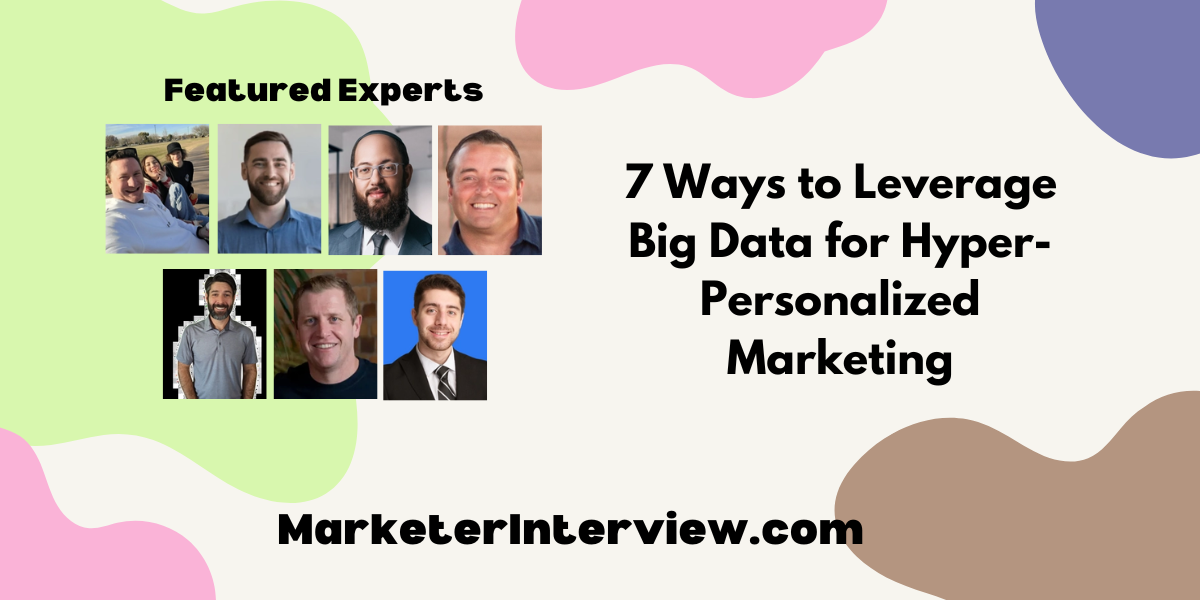7 Ways to Leverage Big Data for Hyper-Personalized Marketing
In the quest to master hyper-personalized marketing using big data, we’ve gathered seven expert tips from top industry professionals including CEOs and Heads of Marketing. From utilizing customer segmentation to creating micro-segments from buyer intent data, these leaders offer their best advice for making your marketing efforts more targeted and effective.
Want to get quoted in MarketerInterview.com content just like this? Apply to become a contributor today!
Contents
Utilize Customer Segmentation
With big data, you have access to a vast amount of information that can help you gain valuable insights into your customers’ behaviors and interests. One specific technique for leveraging big data for hyper-personalized marketing is through customer segmentation. Customer segmentation is the process of dividing your target audience into smaller groups based on shared characteristics such as demographics, behavior patterns, or interests.
By analyzing big data, you can identify commonalities among your customers and create targeted campaigns for each segment. One tip for effective customer segmentation using big data is to use a combination of quantitative and qualitative data. Quantitative data includes numerical information such as purchase history, website clicks, and social media engagement. On the other hand, qualitative data includes more subjective information such as customer feedback and survey responses.
By combining both types of data, you can gain a deeper understanding of your customers’ needs and preferences. For example, analyzing quantitative data may reveal that a certain segment of your audience frequently purchases a specific product. But by also considering qualitative data such as customer feedback, you may discover that they have a particular pain point or preference that can be addressed in your marketing messaging.

Alex Taylor, Head of Marketing, CrownTV
Conduct A/B Testing on Micro-Segments
An insidious tactic our company endorses in the realm of big data is A/B testing on micro-segments. We drill down on the customer data to identify smaller groups, each with distinct preferences.
We then personalize marketing elements—from images to subject lines—and perform A/B tests on these segments. Learning from each interaction helps us constantly evolve the messaging to each micro-segment, thus achieving true hyper-personalization.

Abid Salahi, Co-Founder and CEO, FinlyWealth
Identify and Utilize Key Differentiators
Big data offers a goldmine of information for hyper-personalized marketing, going beyond basic demographics and past purchases. It captures details like website behavior, social media interactions, and email engagement, painting a rich picture of individual customer preferences. The key lies in identifying unique characteristics, or “key differentiators,” within this data. In Carepatron’s case, imagine a customer consistently using templates and resources for a specific topic or healthcare concern versus someone with the same behavior but for different topics.
By leveraging these key differentiators, we can create hyper-personalized experiences. To further refine this experience, we can layer on additional data points like their preferred communication method based on their user behavior and subscriptions (newsletters, participation in SNS, etc.). This method allows us to craft targeted messages and recommendations for a specific segment, encouraging creativity while utilizing platforms already available to us and familiar to our users.
This attention to detail fosters increased customer engagement and loyalty. Customers receive highly relevant messages, leading to a more valuable and personal experience. We can also make data-driven decisions by analyzing the performance of segmented campaigns, further refining our approach. Remember, data privacy is paramount, and marketing automation tools can help manage personalized communication across large customer segments. By mastering key differentiators and narrowed segments, we unlock the true potential of big data for hyper-personalized marketing.

Jamie Frew, CEO, Carepatron
Align Local Campaigns with National Trends
One specific tip for leveraging big data in hyper-personalized marketing is to tap into national or regional trend data to inform and drive hyper-local campaigns. By aligning your local marketing efforts with broader trends that people are hearing about in national media, you can create a sense of relevance and immediacy that resonates on a local level.
For example, if national data indicates a rising interest in sustainable living, a local home goods store could launch a campaign highlighting eco-friendly products, tying in the national conversation with local relevance. They could host workshops on sustainable practices, using regional data to tailor the topics to the local community’s interests and concerns.
Another example might be a local fitness center using data showing a national surge in mindfulness and mental wellness. They could offer specialized yoga or meditation classes timed around Mental Health Awareness Month, capitalizing on the wider public discourse to attract locals seeking ways to engage with these trends in their own community. By leveraging the buzz from national trends, businesses can connect with locals on issues they’re already tuned into, making marketing campaigns more effective and personal.

Joshua Bartlett, Owner, Double Plus Marketing
Predict Customer Behavior with Machine Learning
I’ve found that using big data for hyper-personalized marketing works wonders, and here’s how I do it: I start by segmenting customers based on their activity, likes, and purchases. This lets me build profiles that show patterns and trends, which guide me in making pinpointed marketing strategies.
By adding machine learning, I fine-tune my ability to predict what customers will do or want next, which makes my segments even sharper. This precise technique ensures the marketing messages are right on target, boosting customer engagement and increasing sales. I send these customized messages through personalized emails, targeted social media ads, and bespoke website interfaces.
Also, it’s important for me to monitor data in real time to continuously improve my marketing strategies. Observing customer interactions moment to moment allows me to change my strategies on the fly, helping me capitalize on new trends and resolve issues quickly.
Personalizing content on the go, like suggesting products based on recent purchases or views, really improves the shopping experience. Integrating big data analytics with customer relationship management systems ties everything together, providing me with a comprehensive strategy for personalization across all touchpoints. This technique doesn’t just please customers—it builds deeper loyalty and fuels growth for the business.

Ryan Kelly, Chief Marketing Officer, Easy Ice
Analyze Unstructured Data for Insights
One tip I have for leveraging big data for hyper-personalized marketing is to also analyze unstructured data. This type of data is crucial for making highly personalized recommendations and crafting effective marketing campaigns. While structured data, which is organized into categories in a database, includes essential customer information for business operations, unstructured data can’t be categorized in the same way. You won’t find a specific row or column in your database containing this kind of information.
Typically, unstructured data refers to information stored outside of your site, like social media posts about your brand. You can gather this information using monitoring tools. For instance, certain digital services can track mentions of your brand across the web. This data can help you gauge the sentiment around your brand, understand what people are seeking when they interact with you, and identify products that might interest them. Using this data, you can create content tailored to specific products and customer needs.

Sam Hickson, CEO, TG Wireless
Create Micro-Segments from Buyer Intent Data
PanTerra Networks can leverage the wealth of buyer intent data from ZoomInfo, TrustRadius, and Gartner Digital to create hyper-personalized marketing campaigns. By analyzing these rich data sources, you can build detailed buyer profiles that go beyond basic demographics. Look for signals that indicate active research, buying stage, and specific product interest.
This deep understanding allows you to move beyond traditional segmentation and create highly targeted micro-segments. Instead of just targeting by industry, you can pinpoint multi-site organizations that are actively researching Unified Communication solutions. With these micro-segments in place, you can personalize content and offers to resonate with each group’s specific needs and challenges.
Craft targeted email campaigns, customized landing pages, and retargeting ads that directly address their buying considerations. This hyper-personalized approach dramatically increases the relevance and effectiveness of your marketing efforts.

Shawn Boehme, Director of Sales, PanTerra Networks
Want to get quoted in MarketerInterview.com content just like this? Apply to become a contributor today!






